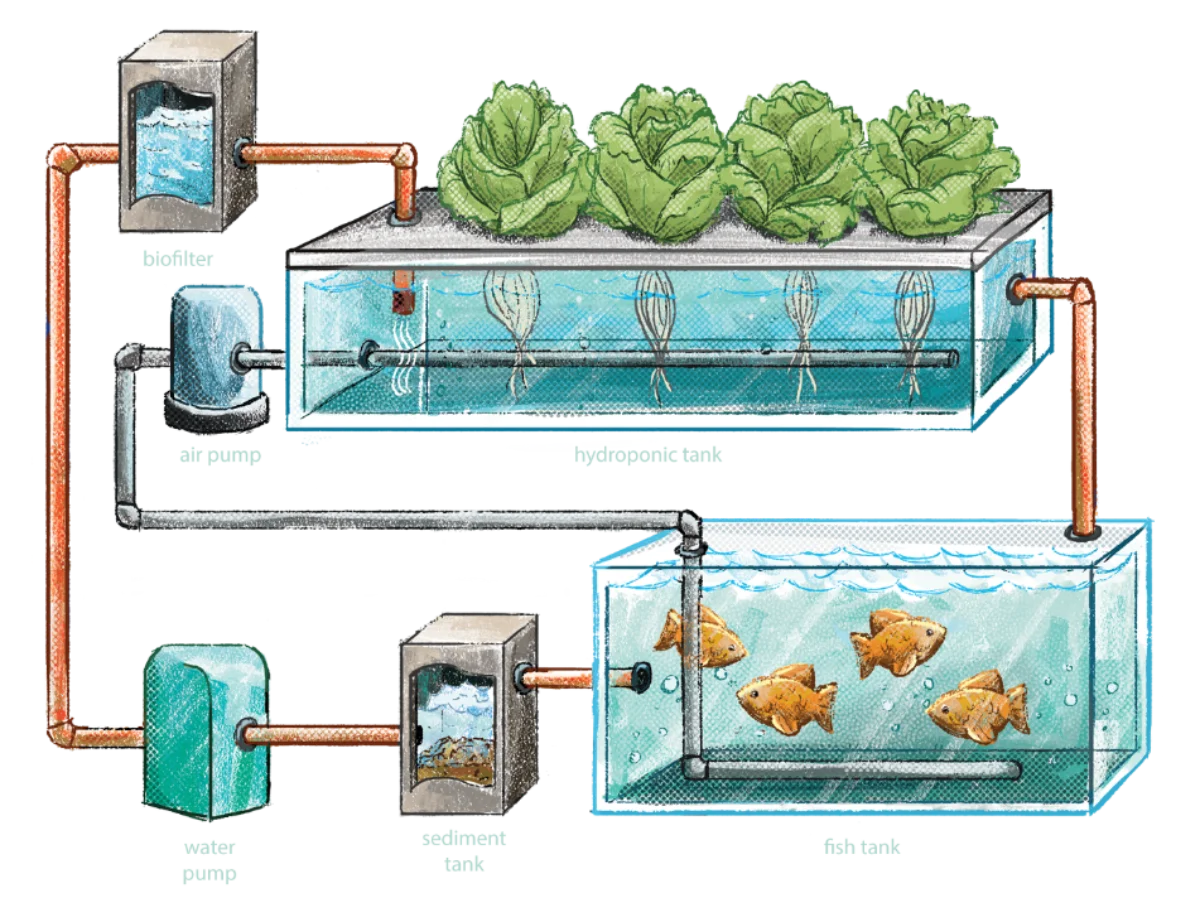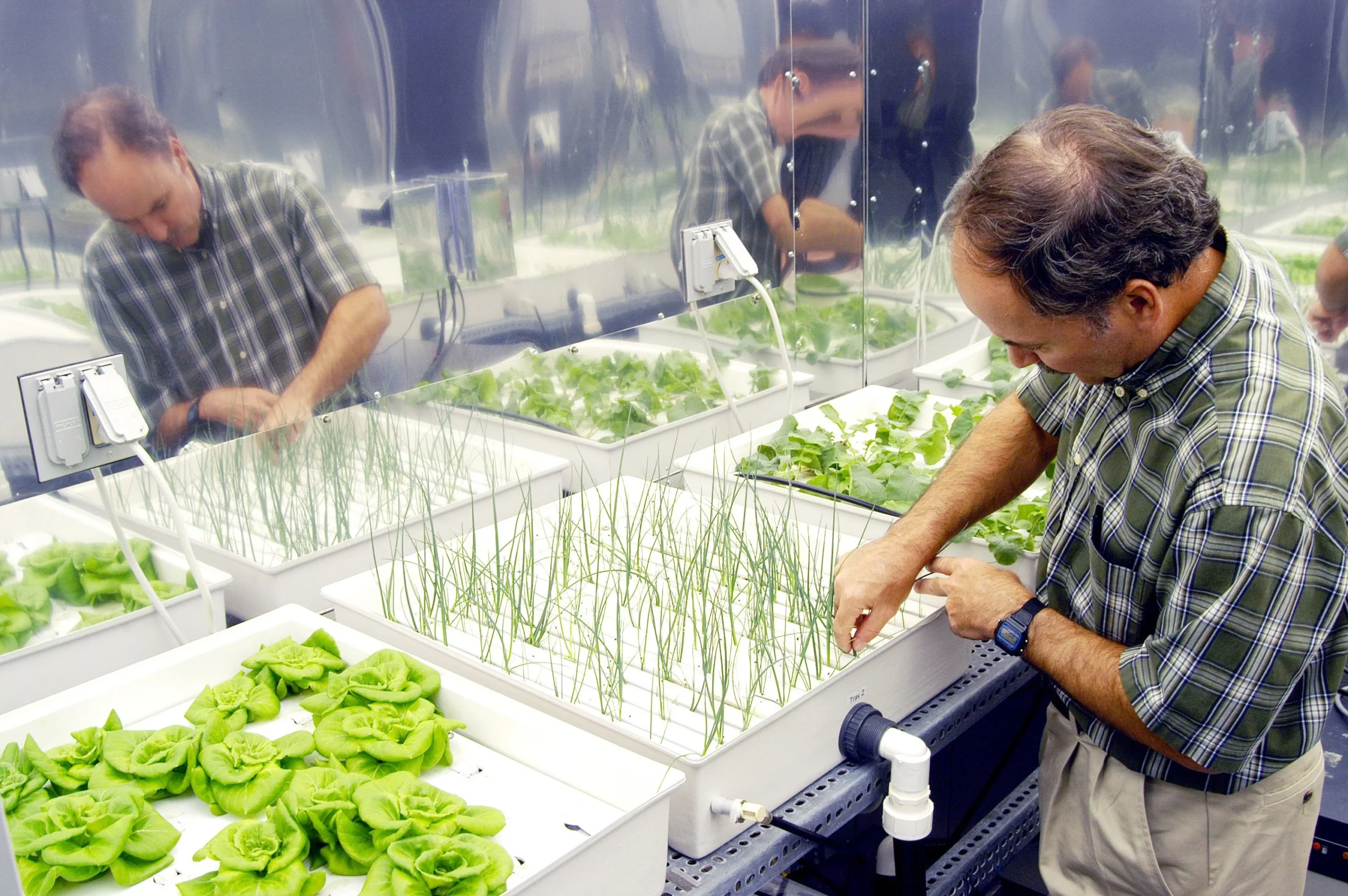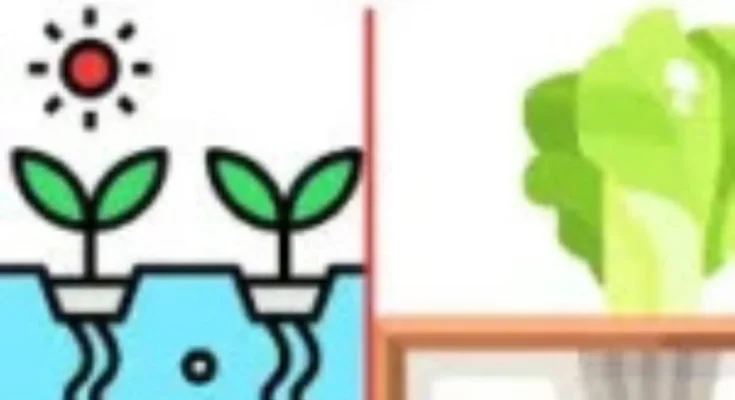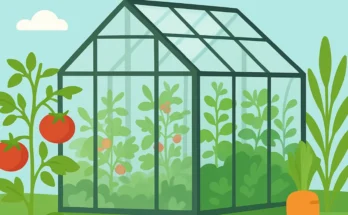Aquaponics vs. Hydroponics: A Modern Take on Soil-Free Farming
As agriculture evolves to meet the demands of a growing population and environmental sustainability, two soil-free farming techniques have emerged at the forefront: hydroponics and aquaponics. These cutting-edge systems present efficient, eco-friendly alternatives to conventional farming by removing the need for soil and reducing water usage.
Though they share common goals and methods, aquaponics and hydroponics operate on different principles and offer unique benefits. Understanding these differences is essential for anyone looking to embrace innovative agricultural practices.
What is Aquaponics?
Aquaponics is an integrated system that brings together two distinct practices—fish farming (aquaculture) and soilless plant cultivation (hydroponics). In this closed-loop ecosystem, fish waste provides a natural fertilizer for plants, while the plants, in turn, help purify the water that recirculates back to the fish tanks. This mutualistic relationship creates a self-regulating environment where both aquatic animals and crops support each other’s growth.

What is Hydroponics?
Hydroponics, by contrast, is solely focused on growing plants in water enriched with nutrient solutions. Without the need for soil, plants receive all essential minerals directly through their roots, allowing for precise control over growth conditions and faster crop yields. Unlike aquaponics, hydroponics does not rely on fish or other aquatic life to function.
Comparing the Two Systems
This article takes a closer look at hydroponics and aquaponics—analyzing how each system works, their respective strengths, and the challenges they present. By comparing these two soil-free farming approaches, you’ll gain the insights needed to choose the right method for your goals—whether you’re aiming to grow food at home, start a sustainable garden, or invest in future-focused agriculture.
How Aquaponics Functions: A Symbiotic Farming System
- Fish Waste as a Natural Fertilizer
In an aquaponics system, a fish stored in a tank produces ammonia-rich waste. Although harmful to fish in large quantities, the waste becomes useful once it comes to the next stage. The waste in the water is pumped to the plant-growing area, where natural filtration begins.
2. Plants Filter the Water
While the ammonia-infused water runs through the grow beds, beneficial bacteria convert ammonia into nitrates, ammonia’s nitrogen is utilized by the plants as nutrients. The plants uptake the nutrients to support their growth and clean up the water.
3. A Recirculating System
Once nutrients have been absorbed by the plants, the clean, filtered water is returned back to the fish tank. This starts a continuous loop in a closed-loop system. With this system, the aquaponics farmer can take advantage of several benefits:
- Environmentally Friendly: Water is reused and reduced waste.
- Cost-Effective: Eliminate chemical fertilizers.
- High Productivity: Provide healthier fish and vigorous plant growth.
- Sustainable: Reduced environmental impact, disruption of natural processes from soil erosion, and pollution found in traditional agriculture.
Core Components of an Aquaponics System
1. Fish Tank:
The fish tank is the primary component that grows the fish. The size and type of fish tank varies based on the scale of the aquaponics system and the type of fish being grown.
2. Grow Beds:
The containers that grow the plants. Grow beds are typically filled with a grow media, such as gravel, clay pellets, or lava rock, which provide the support for plant roots while allowing water to drain and air to circulate.
3. Water Circulation System:
This is a set of pumps and piping that keeps water constantly moving from fish tank to the grow bed and back again. The water is constantly (but not quickly) moving from the fish tank to the grow beds so the plants can get the nutrients and the fish can live in clean water.
4. Biofilter/Bacteria Role:
This system houses beneficial bacteria, which are essential for the aquaponics system. The bacteria take the toxic ammonia which comes from fish waste and convert it into a nitrite before finally being converted to a nitrate which is less harmful and can be taken up as nutrients by the plants. Biological filtration is necessary for healthy plants and fish and for good water quality.
Challenges and Limitations of Aquaponics
1. Time/Cost of Initial Setup: The initial capital costs of setting up aquaponics systems can be significant. Developing a fish tank, grow beds, pumps and aeration systems can be expensive.However aquaponics can save money in the long term in terms of fresh water and fertilizer cost.
2. Care and Maintenance: In any aquaponics system, maintenance and care entails monitoring the water quality, fish health, and plant growth separately and in relation to each other, and then keeping them in balance.
3. Crop Selection: Aquaponics has the ability to grow a wider range of the crops compared to soil based cultivation, but not all crops may do well in aquaponics. Crops can have unique nutrient requirements and in aquaponics supplies nutrients from the fishes. Some crops may be too large for the available grow space. Choosing crop species suited for aquaponics may exclude plants species.
Understanding Hydroponics
What is Hydroponics?
Hydroponics is a method of growing plants without soil, using mineral nutrient solutions in a aqueous solvent. Hydroponics delivers all essential nutrients to the plants directly through the water solution, which allows for more efficient uptake of nutrients by the plant, and also allows for faster growth when compared to traditional soil based growing.
These systems range from basic DIY setups for home growers to intricate installations used in commercial agriculture. Despite the variety, the core idea remains the same: deliver nutrients efficiently to plant roots, whether suspended in water or supported by media like perlite, rock wool, or coco coir.

Exploring How Hydroponics Functions
Hydroponics is a cutting-edge method of growing plants without soil by delivering nutrients directly to their root systems through water. This system enables growers to maintain precise control over nutrient concentrations and environmental factors, leading to faster plant growth and improved overall health.
Various Types of Hydroponic Systems
Hydroponic cultivation can be implemented through several system designs, each utilizing distinct techniques for supplying nutrients and supporting plant life:
1. Nutrient Film Technique (NFT)
In this approach, plant roots are placed in shallow channels where a thin film of nutrient-rich water continuously flows over them. The plants absorb nutrients directly, and the unused solution is recycled back to the main tank.
2. Deep Water Culture (DWC)
Plants are suspended so that their roots dangle directly into a highly oxygenated nutrient solution. An air pump keeps the water oxygenated, allowing plants to thrive in a nutrient-saturated environment.
3. Aeroponics
Roots are left hanging in the air and are intermittently sprayed with a fine mist containing essential nutrients. This technique maximizes oxygen exposure and nutrient absorption, encouraging accelerated plant growth.
4. Ebb and Flow (Flood and Drain)
The grow bed is temporarily filled with nutrient solution, then drained. This flooding cycle gives roots both nutrients and oxygen in alternating intervals, reducing the risk of root rot and supporting healthy development.
5. Drip Irrigation System
Nutrient-rich water is delivered slowly and directly to the base of each plant via small tubes. This system allows for accurate management of nutrient levels and is suitable for both large-scale and home setups.
6. Wick System
This passive method uses absorbent wicks to draw nutrient solution from a reservoir to the plant roots. It’s low-cost, requires no power, and is ideal for beginners or small-scale projects.
Essential Elements of a Hydroponic System
1. Nutrient Reservoir
This container holds the nutrient solution and serves as the system’s core. The reservoir’s size will vary depending on the number of plants and the system’s capacity.
2. Growing Medium
Though soil isn’t used, plants still need structural support. Inert materials like rockwool, clay pellets, coconut coir, perlite, and vermiculite are commonly used to hold plants upright, improve aeration, and retain moisture.
3. Nutrient Solution
A scientifically balanced mix of water and minerals forms the basis of hydroponic plant nutrition. It includes essential macronutrients (like nitrogen, phosphorus, and potassium) and trace micronutrients (such as calcium, magnesium, and iron), tailored to the plants’ specific needs.
4. Pump and Delivery System
Depending on the hydroponic setup, water pumps and tubing move the nutrient solution to the plant roots. These may operate continuously or in cycles to maintain proper hydration and nutrient access.
Challenges and Potential Drawbacks of Hydroponics
- Dependence on Chemical Nutrients
Hydroponics relies on formulated nutrient solutions, which may be costly and are not always environmentally sustainable.
2. Risk of Equipment Malfunction
Since hydroponic systems are heavily dependent on pumps, timers, and aeration devices, mechanical failures can disrupt nutrient flow, putting plant health at risk.
3. Environmental Disposal Issues
Spent nutrient solutions must be disposed of carefully. If mismanaged, they can lead to nutrient runoff that harms soil and water ecosystems nearby.

Aquaponics vs. Hydroponics
Understanding the Core Differences:
Aquaponics and hydroponics are both innovative, soil-free methods of growing plants, but they differ significantly in how they operate, where their nutrients come from, and the complexity involved. Here’s a detailed breakdown of how they compare across several important factors:
1. Nutrient Delivery
A. Aquaponics: Natural Nutrients from Fish Waste
In aquaponic systems, plants derive their nutrients from the organic waste produced by fish. As the fish release waste into the water, beneficial microbes convert it into plant-available nutrients, primarily nitrates. This creates a natural, self-sustaining cycle, eliminating the need for external fertilizers and reducing environmental impact.
B. Hydroponics: Man-Made Nutrient Solutions
Hydroponic systems rely on precisely mixed chemical solutions to feed plants. These solutions contain all the essential macro and micronutrients required for healthy plant development. While highly efficient and customizable, this method depends on artificial inputs, which may not appeal to those seeking a fully organic approach.
2. System Complexity
A.Aquaponics: Dual-System Operation
Managing an aquaponic setup means overseeing both an aquatic environment for fish and a hydroponic environment for plants. This requires knowledge of aquatic animal care, water chemistry, and plant biology. The added layer of biological balance makes aquaponics more intricate.
B.Hydroponics: Singular Focus on Plants
Hydroponic systems are comparatively more straightforward. They revolve solely around optimizing plant growth by adjusting nutrient levels, water flow, and environmental factors. With fewer biological variables involved, hydroponics is easier to learn and maintain for beginners.
3. Water Efficiency
A. Aquaponics: Highly Water-Conserving
Because aquaponics recycles water continuously between the fish tank and grow beds, it uses significantly less water than traditional agriculture. Evaporation and plant uptake are the only real sources of water loss, making it one of the most water-efficient systems available.
B. Hydroponics: Water-Smart but System Dependent
Hydroponics also minimizes water use, especially in recirculating systems like NFT or Deep Water Culture. However, water usage can vary with the system design—drip systems, for example, may consume more water if not managed carefully.
4. Cost and Maintenance
A. Aquaponics: Higher Upfront Cost, Dual Responsibility Building an aquaponic system often involves a larger initial investment due to the need for fish tanks, filtration systems, and water quality monitors. Daily maintenance includes monitoring fish health, feeding schedules, and ensuring water parameters stay balanced.
B. Hydroponics: Variable Costs, Easier Upkeep
Startup costs in hydroponics range from minimal (for DIY systems) to high (for commercial-scale setups). Once the system is running, maintenance generally involves checking nutrient levels and system mechanics, which is simpler than maintaining a living aquatic ecosystem.
5. Variety of Crops
A. Aquaponics: Best Suited for Select Plants
Because the ecosystem must support both fish and plants, aquaponic setups are typically limited to crops that thrive in similar pH and nutrient conditions. Leafy greens, basil, mint, and certain fruiting plants like cherry tomatoes do well in these environments.
B. Hydroponics: Greater Crop Flexibility
Hydroponic systems can support a wide array of plant species, from leafy vegetables and herbs to larger fruiting plants and flowers. This versatility makes hydroponics appealing for both hobbyists and commercial growers seeking variety.

How to Choose Between Aquaponics and Hydroponics
Key Considerations:
Deciding whether aquaponics or hydroponics is better suited for your situation depends on your objectives, available space, level of experience, and sustainability priorities. Here’s a breakdown of important factors to help you select the system that aligns with your needs.
1. Available Space and Resources
A. Aquaponics: Requires More Room and Infrastructure
Aquaponic setups usually occupy more space due to the need for both fish tanks and plant-growing areas. These systems are best implemented in environments where you can manage temperature, humidity, and lighting—like large greenhouses or custom indoor areas.
Best suited for: Spacious areas such as greenhouses, backyards, or controlled indoor environments.
Hydroponics: Compact and Versatile
Hydroponic systems are often more space-efficient and can be tailored to smaller setups. From countertop herb gardens to vertical towers, hydroponics adapts well to urban homes and limited-space environments.
Best suited for: Small apartments, balconies, vertical spaces, or any urban setting with space constraints.
2. Types of Crops You Want to Grow
A. Aquaponics: Balanced Production of Fish and Plants
With aquaponics, your plant choices are partially influenced by what’s suitable for the aquatic ecosystem. Leafy greens, herbs, and some fruiting vegetables like tomatoes or peppers perform well, but you must also ensure the water conditions are healthy for your fish species.
Ideal for: A mixed harvest of vegetables, herbs, and edible fish.
B. Hydroponics: Greater Flexibility in Crop Selection
Hydroponic systems support a wider range of plants since nutrient levels can be customized for each type. Whether you want to grow exotic herbs, seasonal fruits, or flowering plants, hydroponics gives you more control.
Ideal for: Targeted plant production, such as rare crops or off-season varieties.
3. Complexity and Skill Level
A. Aquaponics: Requires More Knowledge and Monitoring
Aquaponics involves the care of two interdependent living systems—plants and fish. This means monitoring water chemistry, feeding fish, and maintaining biological balance. It demands more time and experience but offers a rewarding, self-sustaining ecosystem.
*Best for: Growers with some experience, those eager to learn, or hobbyists committed to a hands-on approach.
B. Hydroponics: Easier to Learn and Maintain
Hydroponic gardening is generally more straightforward. Once the system is set up, growers mainly focus on managing nutrient concentrations, water flow, and plant health. It’s ideal for those who want a less complicated path into soil-free farming.
*Best for: Beginners, educators, home growers, or anyone seeking simplicity and control.
4. Environmental and Sustainability Goals**
A. Aquaponics: Eco-Friendly and Organic
Aquaponics shines in sustainability, operating on a closed-loop cycle where water and nutrients are continually reused. It doesn’t require synthetic fertilizers or pesticides, making it a natural choice for eco-conscious growers seeking organic production methods.
B. Hydroponics: Resource-Efficient, with Some Trade-Offs
Although hydroponics uses far less water than traditional farming, it relies on manufactured nutrients and often needs artificial lighting, especially in indoor or off-season setups. Still, it offers a sustainable alternative where soil is poor or space is limited.
Conclusion: Finding the Right Growing System for You
Aquaponics and hydroponics each present their own unique benefits and considerations, offering sustainable and innovative alternatives to soil-based agriculture. The right choice for you hinges on your personal objectives, available resources, and willingness to engage with system complexity.
Aquaponics: A Complete Ecosystem Approach
Aquaponics is ideal for those who want to embrace an environmentally harmonious system that mimics natural ecosystems. Its efficient use of water, minimal waste, and potential for chemical-free, organic growth are major draws. However, the need to manage both aquatic life and plant health makes it more complex, and it typically demands higher upfront investment and a deeper learning curve.
Hydroponics: Efficient and Scalable Cultivation
If you’re seeking a more streamlined, space-saving, and easily scalable system, hydroponics may be the better choice. It allows for precise nutrient management and quick crop cycles, making it suitable for urban environments, beginners, and commercial-scale production. That said, it does depend on synthetic nutrients and requires careful monitoring to maintain optimal conditions.
Which One Fits You Best?
- Choose aquaponics if you value a self-sustaining system, don’t mind the extra responsibility of fish care, and are committed to eco-friendly practices.
- Go with hydroponics if you prefer a simpler, plant-focused system that is easier to set up, maintain, and scale over time
No matter your choice, both systems empower you to grow fresh, healthy food while reducing your environmental footprint.
for more information, just visit:https://sam-roon.com/




I was curious if you ever thought of changing the page layout of your website? Its very well written; I love what youve got to say. But maybe you could a little more in the way of content so people could connect with it better. Youve got an awful lot of text for only having one or 2 pictures. Maybe you could space it out better?
Please provide me with more details on the topic http://www.kayswell.com
Ищете подробную информацию коллекционеров? Наш сайт предоставляет исчерпывающие материалы погружения в тему нумизматики!
У нас вы найдёте коллекционные монеты из разных эпох , а также драгоценные находки.
Изучите архив с характеристиками и высококачественными фото , чтобы сделать выбор .
монета Сеятель
Если вы начинающий или профессиональный коллекционер , наши статьи и гайды помогут углубить экспертизу.
Воспользуйтесь возможностью приобрести эксклюзивные артефакты с сертификатами.
Станьте частью сообщества ценителей и следите последних новостей в мире нумизматики.
Thanks for another fantastic post. Where else could anybody get that type of information in such an ideal way of writing? I have a presentation next week, and I am on the look for such info.
Thanks for your thoughts. One thing I’ve noticed is banks along with financial institutions really know the spending habits of consumers as well as understand that many people max out and about their own credit cards around the trips. They wisely take advantage of this specific fact and start flooding your own inbox and snail-mail box by using hundreds of no-interest APR credit cards offers immediately after the holiday season comes to an end. Knowing that for anyone who is like 98 of all American public, you’ll get at the opportunity to consolidate consumer credit card debt and transfer balances towards 0 apr interest rates credit cards.
What i do not understood is actually how you’re not actually much more well-liked than you may be right now. You are so intelligent. You realize thus significantly relating to this subject, made me personally consider it from a lot of varied angles. Its like women and men aren’t fascinated unless it is one thing to do with Lady gaga! Your own stuffs great. Always maintain it up!
I definitely wanted to jot down a simple note to say thanks to you for all of the lovely hints you are placing here. My particularly long internet research has at the end of the day been rewarded with reliable content to write about with my company. I would say that we site visitors are extremely blessed to be in a fantastic community with very many perfect people with useful concepts. I feel pretty grateful to have used your webpage and look forward to so many more cool moments reading here. Thanks once more for a lot of things.
thank you very much and i hope to place more
Great content! Super high-quality! Keep it up! http://www.hairstylesvip.com
Thanks for your help and for writing this post. It’s been great. http://www.kayswell.com